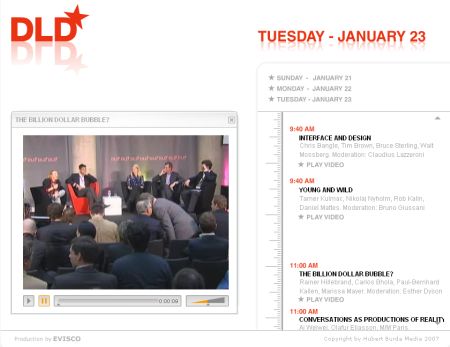von Roland Hachmann | Feb. 9, 2007 | Ad News, Blog, Digital Marketing
Following a viral, almost guerilla-type marketing incident that went horribly wrong, Sean Carton of Clickz deducts 5 rules for this kind of marketing that should be obeyed.
- If you want to generate word-of-mouth, don’t try to be hip.
Just because it seems to the latest buzz around the blog, doesn’t mean it spreads. Don’t try too hard, people will inevitably notice and block it.
- Destruction of property or intruding into people’s comfort zones will only backfire.
Some viral marketing is very obtrusive and tries to surprise people by being as drastic as damaging or at least defacing public spaces. This might cause more trouble than anythings else.
- You can’t fake authenticity.
No, of course you can’t. And marketers should never ever think they can, because the truth behind every little marketing trick will surface these days.
You better do! Obvious, as it seems, but sometimes viral marketing expectations are formulated in a way that goes completely beyond what would be sensible or even possible with a certain target audience.
This shouldn’t be a new concept to anyone, otherwise – well…
von Roland Hachmann | Feb. 6, 2007 | Ad News, Blog, Digital Marketing, Marketing, Online Advertising
Clickz references a study about user generated content – or consumer generated content, as it should rather be called. This is from August 2006, but nevertheless quite interesting, as there seems to be some interesting findings even related to „traditional“ internet advertising:
Almost three-quarters of people who publish amateur video content online are under 25, and of those, 86 percent are male. […] Other findings of the „Generator Motivations Study“ include that as many as 73 percent of content generators notice Internet advertising, a much higher ration than what’s found in the male 18 to 24 year-old demographic as a whole. Also, 57 percent of all content creators surveyed said they are willing to feature brands in their videos, and many within the group have already done so. […] The report suggests opportunity for marketers, if campaigns are executed properly. „Approaching the right communities, with the right tone and incentives can motivate users to generate content featuring brands,“ the report said.
Sounds good, being from Germany, I now wonder if the situation is (or will be) similar in Germany?
von Roland Hachmann | Jan. 28, 2007 | Blog, Digital Culture, Digital Marketing
Here is a curious initiative: Sweden to set up embassy in Second Life
Sweden is to become the first country to establish diplomatic representation in the virtual reality world of Second Life, officials said on Friday.
„We are planning to establish a Swedish embassy in Second Life primarily as an information portal for Sweden,“ Swedish Institute (SI) director Olle Wästberg told AFP.
They won’t issue visa, instead they will tell people how the obtain visa for Sweden in the real world. And they want to inform people of how nice and beautiful Sweden is… This sounds more like a regular tourist information to me, than an embassy. But nevermind – I like Sweden and I hope this helps.
von Roland Hachmann | Jan. 23, 2007 | Blog, Digital Culture, Digital Marketing
Ok, there goes the weekend. Guess I’ll be pretty busy – I just found out that you can watch all the videos of the “Digital Life Design†Day on the DLD 07 Media Website. See Marissa Mayer of Google speak about the billion dollar bubble or John Naisbitt about “Mind Set!â€, probably based on his new book. Or Luc Besson, Craig Newmark, David Sifry, Arianna Huffington. See? Guess you’ll be busy, too. 
von Roland Hachmann | Jan. 20, 2007 | Blog, Digital Marketing, Digital News, Online Advertising
On the Church of the Customer Blog is an interesting Post about CBS Subscription figures on YouTube.
in the first three months of having CBS content on YouTube more than 40,000 people subscribed to the CBS channel. Plus, it had tallied 75 million total views of the 700+ CBS-uploaded videos.
They calculate out the possible (!) longer term figures resulting in more than 300 million pageviews and 160.000 subscribers. But the number of 160.000 is much more important and valueable than the number of pageviews.
Subscriber growth is really the new keystone measure of success because it’s the best indicator of your ability to create loyalty.
This is absolutely true. For some reason, we have forgotten about the bursting bubble a few years back and we have again started talking about millions of video and page views and downloads (and pageviews are no longer a strong currency).
But the true value of the new web2.0 platforms doesn’t reside in the reach of eyeballs itself, but in the stickiness factor of glueing these eyeballs to the site, day after day. Loyalty, in a word. And the possibility to extract complex profiles through user data and behaviour for targetting, as well as maximising the frequency of interaction by the user through this knowledge. Ever more important, since most web2.0 business models are relying on advertising for funding. (And it can’t all just be Google Adsense, I suppose.)
So, in order to avoid the web 1.0 bubble, you should ask the following questions when considering web2.0 business models.
- Will users come back frequently for new content? Easy in communities of user generated content, you should think, because the content changes all the time. But then: what is the start-page of the user for any given page? When I go to YouTube, it shows some of the latest videos, which makes it interesting everyday. Visiting Flickr, I see my own pictures&profile first and I have to click through a couple of menues in order to get to any new or interesting pictures. The first view of flickr is usually quite boring, even though the whole site is based on user generated content. So you need to consider if the page is actually suggesting added value right from the beginning.
- Can users easily be identified as unique users based on a registration? I suppose all web2.0-ish plattforms require the users to register in a more or less detailed way in order to publish content. However, not all websites make it easy to sign on, i.e. automatic sign on. Some platforms recognise you through a cookie, so that you don’t have to login, some don’t – so the user gets a generic start page. These users might spend a considerable amount of time on the site without registering and we will never be able to match their clickpaths to their profile.
- Will it be possible to profile these users on preferences? Speaking of visitors having to register, are we asking them for their preferences? Are we trying to find out, what they are interested in and what areas of interest they may talk to them about in the future? (In order to offer more targetted advertising, of course.)
- Will it be possible to profile these users based on behavioural data? And if they don’t register for certain topics, will we at least gain insights through behavioural data, measuring and tracking their paths through our website in order to find out, what they like? Would we even have it on top of the other data they gave us during registration (which would be best)?
Eyeballs are valuable, no doubt. But eyeballs that we know certain things about are even more valuable, especially if we can differentiate between the eyeballs of the top 20% and the other 80% – thinking about the Pareto principle. In future, those web 2.0 platforms will succeed, that can link the pure webstats to concrete user profiles that offer the possible insights of “qualified leads†to companies advertising on that site.
All of this is already possible, I think, but at the same time I get the feeling, that most web2.0 sites are still mostly interested in maximising eyeballs and (general) profiles – neglecting the deeper profiling opportunities that advertisers will soon ask for.
von Roland Hachmann | Jan. 15, 2007 | Ad News, Blog, Digital Marketing, Online Advertising
Clickz mentions a survey in which 500 direct marketers were asked about they spending plans in 2007. The result? A visible shift towards online.
As many as 85 percent of direct marketers and service providers say they will move dollars to e-mail and Internet channels
Now this is great, but:
Meanwhile, a comparatively meager 51 percent say they will increase their offline budgets.
Hey, that’s still half of the sample asked in this survey! The reason: there will be a general increase of budgets in DM:
“The survey indicated there’s going to be a lot of growth across the board, but especially online and e-mail marketing,†Alterian Director of Marketing Joe Stanhope told ClickZ News.
E-Mail will be the winner, so watch out for even more clutter in your inbox:
Eighty-one percent plan to increase spending on the channel, while 50 percent intend to up their direct mail budget and 45 percent say they will spend more on personalized landing pages.
The last quote once again proves that one of the main benefits of the online channel – the measurability – is yet to be discovered by many. But if they do, they know.
Companies most comfortable with online and e-mail marketing are in large part the ones that have invested in analytics. “There is a correlation between channel integration and analytics,†said Stanhope. “If a marketer has gotten to this sophistication level where they’re doing integrated marketing campaigns, those are the people sophisticated enough to have that kind of infrastructure to carry out analysis.â€


 Wo ich sonst so bin...
Wo ich sonst so bin...